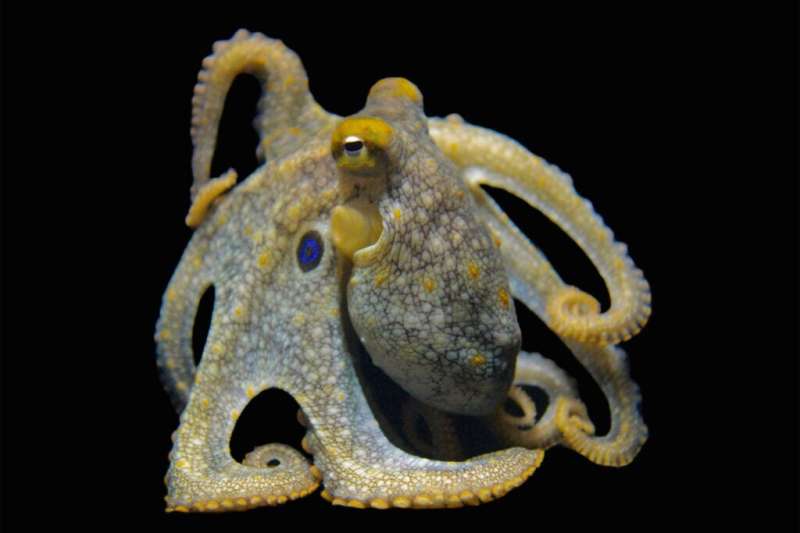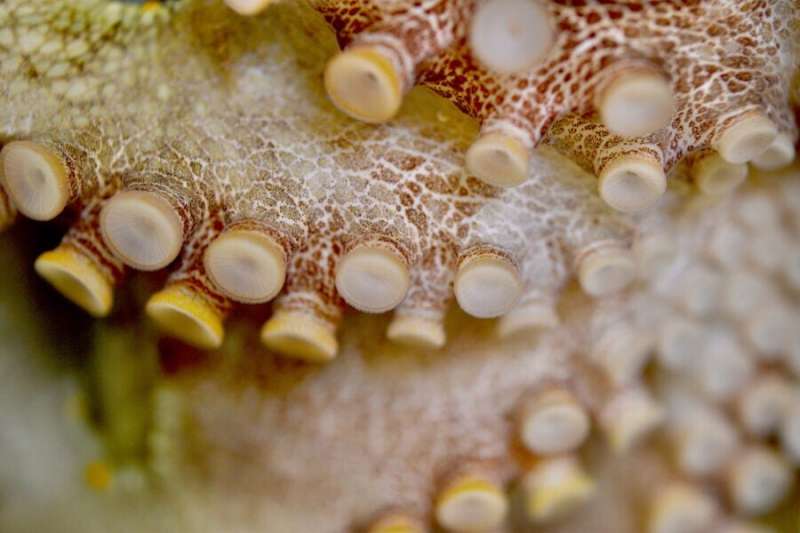This article has been reviewed according to Science X's editorial process and policies. Editors have highlighted the following attributes while ensuring the content's credibility:
fact-checked
peer-reviewed publication
trusted source
proofread
Taking a lesson in evolutionary adaptation from octopus, squid

Cephalopods such as octopus and squid evolutionarily diverged from mollusks like slugs and snails. These animals have elaborate compact nervous systems located within specialized arm appendages, which can perform a surprisingly diverse group of behaviors.
So how did these animals evolve neurologically from the shelled mollusk to a behaviorally sophisticated creature?
In two separate studies published in Nature, researchers from the Bellono lab at Harvard and Ryan Hibbs' lab at UC San Diego discovered some clues, focusing on how cephalopod nervous systems adapt to sense their marine environments. They describe how the animals evolved using a family of chemotactile receptors within their arms and offer a glimpse into how such functional changes likely took place as adaptations to environment over deep evolutionary time.
In the first of the papers, the researchers describe how the octopus repurposes ancestral neurotransmitter receptors to sense its external environment. They discovered that octopus chemotactile receptors evolved from acetylcholine neurotransmitter receptors, the same kind that humans have at our neuromuscular junction. Instead of sensing neurotransmitters, however, octopus receptors contain important adaptations to sense relatively insoluble, greasy molecules that stick to surfaces.
"They use their arms for 'taste by touch' contact-dependent aquatic exploration of crevices in the sea floor," said senior investigator Nicholas Bellono, associate professor in the Department of Molecular and Cellular Biology.
The team determined the 3D structure of the octopus chemotactile receptor and compared it with the acetylcholine receptor to examine how it transitioned from its ancestral role in neurotransmission. The overall architecture of the two receptors looked similar.
"But the binding pocket of the octopus receptor, although in a similar spot that the ancestral neurotransmitter sticks to, is very different," Bellono said of the large, sticky surface. "And we discovered that the binding pocket is under evolutionary selective pressure."
This explains how an animal like the octopus can transition from neurotransmission to environmental chemosensation, such as a sense of smell or taste, by subtly changing just part of the protein to create a new receptor and behavioral function.

In contrast with their octopus cousins, squid are ambush predators that strike and capture unsuspecting prey with their eight arms and two long tentacles. Rather than using their arms to probe surfaces, they grab prey, reeling it in to eat.
"In the second paper, we found that the squid's chemical receptors are more analogous to our sense of taste," Bellono said. The team discovered that squid receptors have adapted to sense bitter molecules. If a squid senses bitterness, it may interpret it as toxic or undesirable and will release its prey. Again, the team found the major difference between the human neurotransmitter receptor and the squid receptor was in the binding pocket.
"In this case, there were fewer receptors than in the octopus, and they looked more like the neurotransmitter binding pocket in that it can bind more hydrophilic molecules," said Bellono. "We see this difference between the octopus and squid as reflecting an evolutionary timeline and adaptation, where we see transition from neurotransmission in acetylcholine receptors to soluble bitter taste in the squid, to the most recent innovation of taste-by-touch sensing of insoluble molecules in octopus."
In 2020, Bellono's team first reported that octopus use chemotactile receptors in their arms to search and explore their environments. Together, these two new papers provide a basis for understanding how subtle structural adaptations, such as those in cephalopod receptors, can drive new behaviors suited to an animal's specific ecological context.
"Cephalopods are excellent models for studying evolution. These studies present a nice and unexpected example of how to exploit these creatures to study biological innovation from atomic to organismal levels," Bellono said.
More information: Corey A. H. Allard et al, Structural basis of sensory receptor evolution in octopus, Nature (2023). DOI: 10.1038/s41586-023-05822-1
Guipeun Kang et al, Sensory specializations drive octopus and squid behaviour, Nature (2023). DOI: 10.1038/s41586-023-05808-z
Journal information: Nature
Provided by Harvard University
This story is published courtesy of the Harvard Gazette, Harvard University's official newspaper. For additional university news, visit Harvard.edu.




















